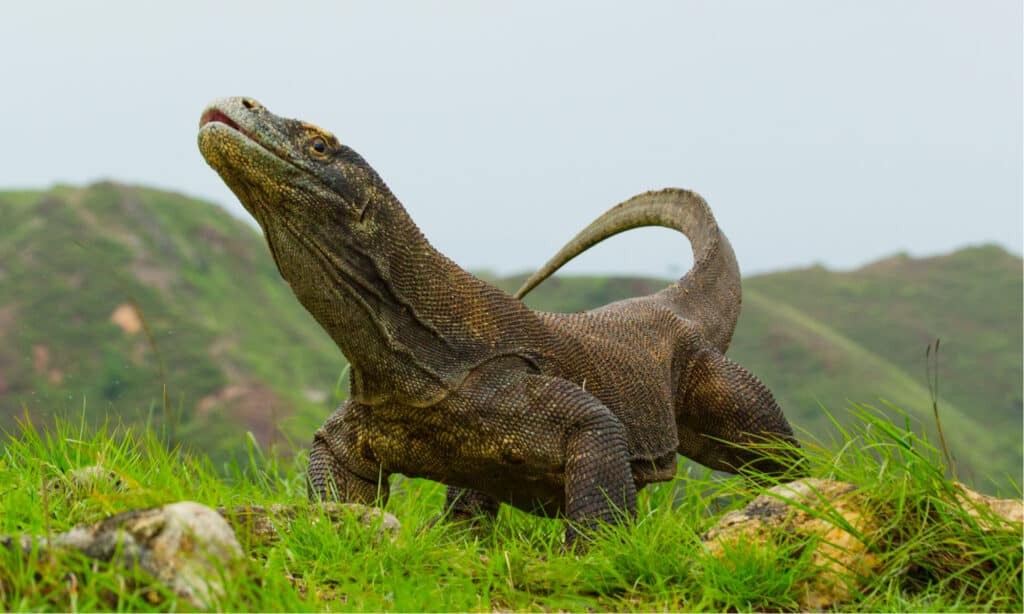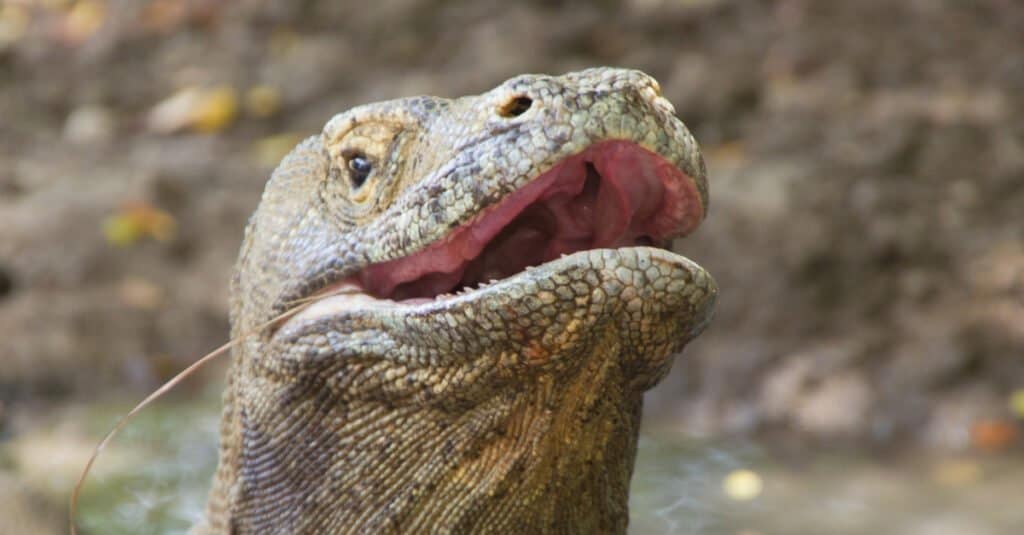Reptiles are some of the most fascinating creatures to roam the earth still. What might be more interesting than watching reptiles do their thing is watching two of the most fearsome reptiles engage in a fight and wondering which of them would win. Imagine a fight between a Komodo dragon and a boa constrictor. It would be difficult to determine which of these animals would win because of their unique strengths and abilities. However, based on available resources, this article will compare these animals’ strengths and features and how each can contribute to the fight and help pick a likely winner.
Comparing a Komodo Dragon and a Boa Constrictor
| Komodo Dragon | Boa Constrictor | |
|---|---|---|
| Size | Weight: 300 lbs or more Length: Can reach lengths of 10 feet | Weight: Can weigh up to 100 lbs Length: They usually reach a length of 13 feet |
| Habitat | Dry savannahs, dried-up river beds, hillsides, etc. | Woodlands, grasslands, tropical forests, and semi-deserts |
| Diet | Carnivorous predator | Carnivore |
| Speed | 10 to 13 mph | One mph |
| Bite Power and Teeth | 500 to 600 PSI or 39 Newtons 60 sharp, serrated teeth | These snakes have no recorded bite force because they do not bite, but they have a squeeze force of 6 to 12 PSI 100 small, sharp, and hooked teeth |
| Predatory Behavior | They attack prey, no matter the size, and then bite them enough to insert their venom, after which they wait for the venom to take effect. | They stalk their prey, catch them, and squeeze their life out. |
What Are the Key Factors in a Fight Between a Komodo Dragon and a Boa Constrictor?
It would be a rare sight to watch these two large reptiles get into a fight primarily because of their difference in habitat. However, to accurately determine which of them might win a fight, if there is one, there needs to be a critical evaluation of certain key factors that could influence the fight. Here are a few of these factors:
Komodo Dragon vs. Boa Constrictor: Size and Speed

Komodo dragons can grow as large as 300 pounds and can reach a length of around 10 feet.
©GUDKOV ANDREY/Shutterstock.com
Imagine a komodo dragon as a gigantic lizard; this means they are almost 100 times the size of an average lizard. These enormous reptiles can grow as large as 300 pounds and reach around 10 feet long. Despite their hefty size, komodo dragons are relatively fast on their short and muscular legs, reaching around 10 to 13 mph. For comparison purposes, the average human moves at a speed of 8 mph while running.
On the other hand, although very long, boa constrictors are not as big as komodo dragons. These snakes can reach around 13 feet long but typically do not weigh more than 100 lbs. These snakes move very slowly and with precision, rarely going past the speed of one mph. Because these snakes have no legs, like every other snake, they have to drag their weight on their bellies which slows them down even more.
Judging by their sizes and speeds, if these animals ever got into a fight, the komodo dragon would have the upper hand because of its ability to move fast, helping it evade the boa constrictor.
Komodo Dragon vs. Boa Constrictor: Predatory Behavior

Boa constrictors are ambush hunters, which means that they wait until their target is close enough to attack before striking quickly.
©Jan Hejda/Shutterstock.com
Komodo dragons are carnivores and will consume practically anything, including carrion, deer, pigs, and even enormous water buffalo, as they are the dominating predators on the few islands they call home. As mentioned, these large reptiles are predators. With the help of their camouflage abilities, they can lie hidden in the vegetation, camouflaged by gray-brown skin, waiting for passing prey. This animal has sharp, serrated teeth that are effective for killing and ripping flesh but are useless for chewing. Instead of chewing, once they rip off pieces from their prey, they swallow them whole with the help of their flexible neck muscles.
For boa constrictors, hunting is a little different. Boa constrictors are ambush hunters, which means that they wait until their target is close enough to attack before striking quickly. Once they attack, they start strangling their prey — monkeys, other reptiles, and wild pigs — before consuming them whole. Despite needing to crush their prey before swallowing it whole, these snakes have very sharp teeth scattered around their mouth to help hold down the prey while it is being pushed down their throat.
Based on their predatory behaviors, both animals carefully stalk their prey before attacking. Still, the boa constrictor has an advantage in this situation because despite not being able to bite its prey, it can coil around it, suffocating the life out of it.
Komodo Dragon vs. Boa Constrictor: Attack Methodology and Defense Mechanism
Naturally, Komodo dragons are aggressive reptiles with powerful venom that they transmit through their razor-sharp teeth, and this venom can easily kill a human within hours. Although there are only a few instances of Komodo dragon attacks on humans, these large reptiles are no strangers to taking out their aggression on other smaller animals. The dragon charges, eviscerating its prey with its razor-sharp claws and serrated, shark-like fangs as it walks past.
Even if they cannot immediately kill their prey, they still bite and will follow the victim for miles as they wait for it to succumb to sepsis brought on by lethal bacteria in their mouth. Adult Komodo dragons have no natural predators in their native habitats since they are the most dominant predators in that area. Komodo dragons have a suit of armor formed of microscopic bones beneath their scales. The dragons are covered in these bones from head to tail, forming a protective barrier that shields the enormous predators.
On the other hand, the boa constrictor’s first defense against predators is its camouflage. The boa constrictor’s skin is colored and patterned to make it easier for them to blend into their surroundings. However, they will attack if surrounded and have no way out. They have a lot of hooked teeth inside of their jaws, despite not being venomous. The hooked teeth of a boa constrictor point toward the back of its mouth, making it challenging for an animal to escape a bite. This means that for an animal to escape the bite of a boa constrictor, the snake has to decide to release it.
Both animals have excellent attack and defense mechanisms.
Komodo Dragon vs. Boa Constrictor: Who Would Win in a Fight?

The Komodo dragon would likely come out victorious in a fight against the boa constrictor.
©vladivlad/Shutterstock.com
Based on the facts above, the Komodo dragon might win in a fight against the boa constrictor. These giant lizards are faster than the boa constrictor, meaning there is no way for the snake to outrun it. Although the snake has camouflage abilities, all the lizard has to do is bite it once and wait for its venom to take effect. If the snake tries to fight back by either holding on to the Komodo dragon or wrapping itself around it, it probably would not be successful because this large lizard has an extra layer of protection under its scales.
Animals That Could Take Down a Komodo Dragon
Komodo dragons are large and aggressive venomous reptiles that can reach up to 300 pounds and about 10 feet long, but there are several, much larger animals that could take down a Komodo dragon.
While the Komodo dragon would win out in a fight with a boa constrictor, if it went up against an anaconda, this snake species would be the victor. Anacondas have the advantage when it comes to size, senses, and defenses, and the result of an anaconda vs a Komodo dragon would likely be the snake wrapping up the lizard and crushing it to death.
Another reptile that could take out a Komodo dragon is the alligator. The Komodo’s venom would be too slow-acting to affect the larger animal in combat. Once the alligator bites the Komodo’s head, neck, or a limb with its incredible bone-breaking 3,000 PSI force, the smaller reptile is likely to be incapacitated and if not killed the alligator could perform a fatal death-roll.
Other powerful animals we’ve written about that could take down a Komodo dragon in a fight include the lion, grizzly bear, crocodile, shark, tiger, and gorilla.
The photo featured at the top of this post is ©
Sources
- , Available here: https://pubmed.ncbi.nlm.nih.gov/6894444/
- Jessie Szalay, Available here: https://www.livescience.com/52787-boa-constrictor-facts.html
- , Available here: https://www.jsg.utexas.edu/news/2019/11/dragon-defense/
Thank you for reading! Have some feedback for us? Contact the AZ Animals editorial team.






